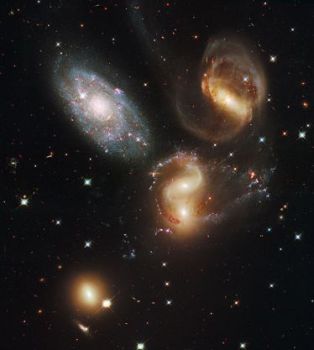Dec 3 2014
The Milky Way is destined to collide with the Andromeda Galaxy in the distant future, as this simulation shows. Indeed, one theory holds that such a collision of galaxies results in massive galaxies. All massive galaxies have at their center a supermassive black hole, the largest type of black hole. How do the supermassive black holes grow to their size?
 The title of the next astronomy talk at UC Riverside is “Colliding Galaxies: A Recipe for Growing Supermassive Black Holes." Image credit: NASA, ESA, and the Hubble SM4 ERO Team.
The title of the next astronomy talk at UC Riverside is “Colliding Galaxies: A Recipe for Growing Supermassive Black Holes." Image credit: NASA, ESA, and the Hubble SM4 ERO Team.
Vivian U, a postdoctoral researcher in the Department of Physics and Astronomy at the University of California, Riverside, will give a free public talk on campus at 6 p.m. on Thursday, Dec. 4, that will address this question.
“I will discuss merging galaxies as a way of growing these supermassive black holes, and how astronomers use the large 10-meter Keck Telescopes to probe the fuel that feeds these powerful, hungry monsters,” U said.
Her talk, titled “Colliding Galaxies: A Recipe for Growing Supermassive Black Holes,” will take place in Room 302, the Highlander Union Building.
U explained that with the help of the Keck Telescopes, astronomers are able to measure masses of black holes in the centers of nearby galaxies, highlighting the key role black holes play in galaxy evolution.
“With the next-generation Thirty Meter Telescope Observatory project of which UCR is a part, we will be able to probe even deeper into exciting uncharted territories of supermassive black holes,” she said.
U received her Bachelor of Science degree in astrophysics in 2006 from the California Institute of Technology, and then her Ph.D. in astronomy from the University of Hawaii at Manoa in 2012. She was also a visiting predoctoral fellow at the Harvard-Smithsonian Center for Astrophysics, and a recipient of the NASA-Harriett G. Jenkins Predoctoral Fellowship. She is currently the Thirty Meter Telescope (TMT) Postdoctoral Scholar at UC Riverside working on the InfraRed Multi-object Spectrometer, one of the three first-light instruments that will be on the TMT.
Her talk is the second in a series of astronomy talks being held at UCR.